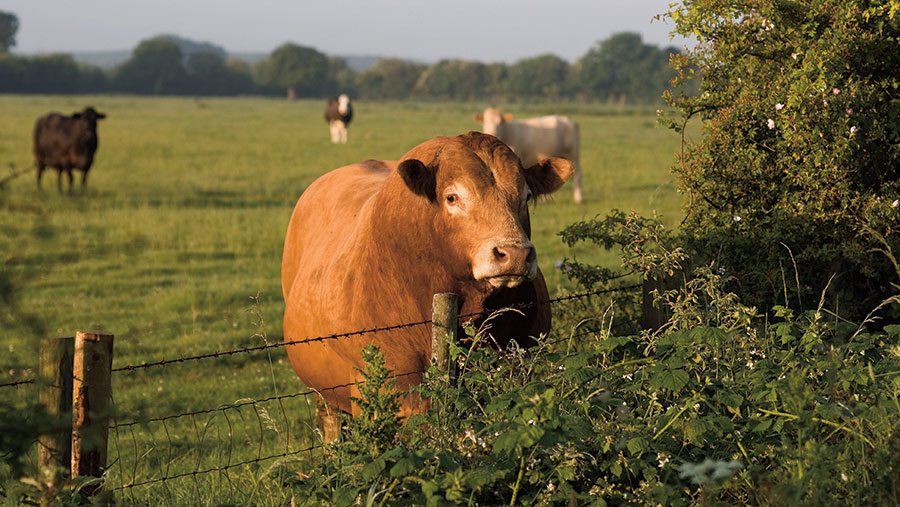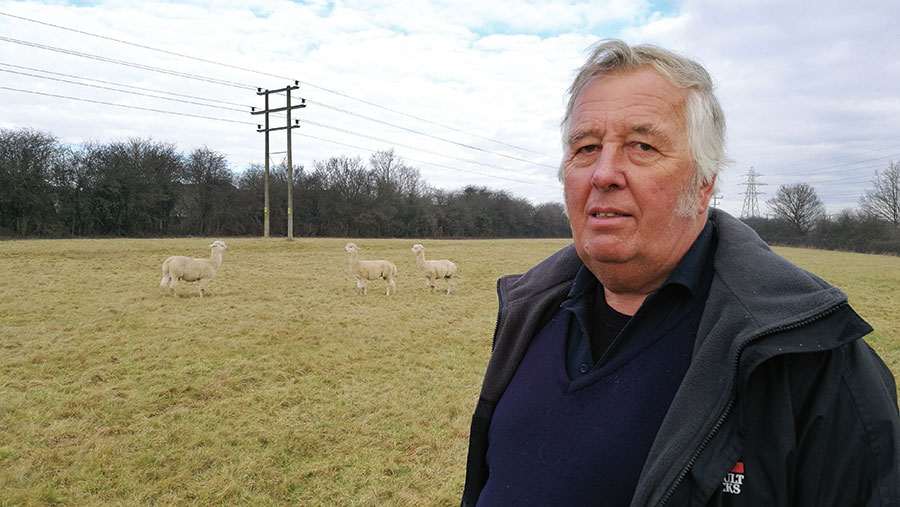What farmers need to know about fencing and the law
 © FLPA/REX/Shutterstock
© FLPA/REX/Shutterstock Public footpaths are always a hot topic for walkers and farmers – and the subject is never far from national headlines.
On average, two to three walkers are killed each year after being attacked by livestock, according to Health and Safety Executive (HSE) figures.
Dozens more are injured, some seriously.
Some farmers have taken extreme measures to keep people away from livestock – erecting steel fences on their land to ensure ramblers and dog walkers do not stray from public crossings.
No farmer wants anybody to die on their farm.
But the penalties for those who fail comply with legislation can be severe, including significant fines and custodial sentences.
See also: How to build the perfect livestock fence
Andrew Gillett, a solicitor at the Country Land and Business Association, advises on public rights of way, access and landowner liability.
Farmers have to make serious legal considerations relating to fencing where public rights of way and livestock are involved, he says.
Bulls in fields
It is an offence to allow a bull in a field crossed by a public right of way, subject to the following exceptions: it won’t be an offence if either the bull in question is under 10 months old; or, it does not belong to a recognised dairy breed and is at large in any field or enclosure in which cows or heifers are also at large.
The Wildlife and Countryside Act 1981 defines dairy breeds to be one of the following: Ayrshire, British Friesian, British Holstein, Dairy Shorthorn, Guernsey, Jersey and Kerry.
Cows with calves
The two most common factors where injuries or deaths have been reported to HSE have been cows with calves at foot and walkers with dogs.
Wherever possible, cows with calves at foot should be kept in fields away from public access.
Fencing then may be a particularly important consideration where land is limited and/or there are cattle that are not suited to fields with public access.
Farmers should keep a close eye on the behaviour of their cattle.
They should assess the temperament of any cattle kept in fields with public access and remove from the group any that have a history of aggression or that may be aggressive because of illness or young calves.
Fencing placement
Once you have decided to fence off the route, where to position the fence is not always straightforward as the position and width of the public right of way may not be known.
It can be recorded on the definitive map and statement, which is kept by the surveying authority (county council or unitary authority).
They may be willing to send you an extract of the map and statement.
If not, you can take a trip down to your local county hall as these documents must be made available for public inspection.
If there is no note of the width on the statement, then further investigations will be necessary.
Obstructions
The courts have made it clear that any encroachment such as buildings or fences on a public right of way will amount to an obstruction and can be a criminal offence.
If the encroachment is noticed you may be required to remove it.
This can be an expensive slip, particularly so if the route has been permanently fenced and this needs to be altered along the entire route.
Barbed wire or electric fences
It is sensible to set barbed wire or electric fences back slightly because if it causes a nuisance to those using the highway you may be liable for any damage caused and the Highway Authority can force you to remove it.
It can help to ensure that barbed wire is not fixed on the public right of way side of the fence.
Where an electrified stock fence is placed alongside a route it should be clearly identified, best practice suggests warning signs should be placed every 50 to 100m.
Gates left open
Farmers should be satisfied that their gates and stiles are adequate to ensure that livestock do not escape, particularly so where a public right of way runs through them.
In the case of Wilson v Donaldson [2004] a walker left a farmer’s gate open allowing cattle to escape to a derelict neighbouring farm and then on to a highway causing a serious accident.
The court found the farmer was liable even though the gate had been left open by a third party.
There was no risk assessment in place and given the field had a public right of way running through it he should have foreseen that the gate might have been left open.
As it was the last line of defence before the road the court felt the farmer should have considered an alternative option for securing the gate, such as a self-closing mechanism.
This shows the high standards the courts expect farmers to adhere to and demonstrates the importance of having adequate public liability insurance.
Gates and stiles
It is possible to apply for authorisation to the local highway authority under section 147 of the Highways Act 1980 to place a new stile or gate across a public right of way, where one has not previously existed.
This power can be used where the land is being, or is going to be used for agriculture and the gate or stile is for “preventing the ingress or egress of animals”.
Statute sets out that stiles and gates must be kept in a safe condition by the owner of the land and so should be checked regularly.
You can claim back at least 25% of your reasonable costs in undertaking such work from the local highway authority (section 146 Highways Act 1980).
To those that let agricultural land, it is worth noting that this duty of maintenance is on the “owner” rather than the occupier.
Landowner liability
The level of liability you owe to a person accessing your land depends on the reason they are there.
You do not owe a duty under either the Occupier’s Liability Act 1957 in relation to visitors, or to trespassers under the Occupier’s Liability Act 1984 where people are using a public right of way.
This does not preclude all forms of liability, for example, injury or damage suffered by those using public rights of way because of livestock or the potential for a breach of health and safety legislation.
Where people wander away from the legal line of the public right of way, counter-intuitively you may owe them a higher duty of care as they then become trespassers.
This is a good reason to ensure public rights of way are adequately waymarked to encourage people to stick to the route.
Best Practice – When looking at the issue of public access and livestock it would be a useful exercise to review foreseeable risks and ensure where possible that you are sufficiently guarded against them, for instance by following best practice as set out in HSE Agriculture Information Sheet 17 “Cattle and public access in England and Wales” [PDF].
It is by no means possible to prevent all future accidents so it is important to ensure that you have adequate and up-to-date public liability insurance cover.
Case study: Cow attack farmer ‘blatantly ignored’ rules
In December, veteran farmer Brian Godwin was handed a 12-month prison sentence, suspended for two years, and ordered to pay £30,000 costs after Mike Porter, 66, was trampled to death as he walked across a footpath.

Brian Goodwin © Solent News
The court heard that Mr Godwin, 83, ignored official warnings to control his herd of Limousin cows to protect dog walkers as he failed to follow HSE recommendations to install electric fencing at his 400-acre farm, in Turleigh, near Bradford-on-Avon, Wiltshire.
Sentencing Mr Godwin, Judge Tim Mousley QC said Mr Godwin had “blatantly ignored” the safety of people who came on to his land.
The judge advised landowners, where possible, to avoid keeping cows with calves in fields with public footpaths.
He also said temporary fencing was a “cheap and easy” way to keep cattle and walkers apart, although the National Beef Association said this was “impractical” for many farmers.
Case study: Steel fence stops dog walkers straying on to field
Landowner Alan Brunt was so fed-up with dog walkers allowing their pets to run amok across his meadow he decided to erect a 300ft metal fence.
Mr Brunt installed the fence in April 2014 along an unofficial walkway near Frome, Somerset, to protect his livestock from risk of disease from dog mess, which creates germs (neospora) that can cause cattle abortion.

Alan Brunt
The 17ha field has been cleaned and is now used to grow good quality horse hay. Livestock including alpacas and cattle – and a bull – have recently been allowed to return to the field.
Mr Brunt says the 6ft-high steel spiked fence gives him peace of mind that his animals and the public are safe.
“We used to see professional dog-walking companies come out here. They would take eight dogs, open the back of a van and let them run across the field,” he explains.
“The dogs were completely out of control. They would be allowed to do whatever they want. They would be in the hedges and the owners wouldn’t pick up after them.”
